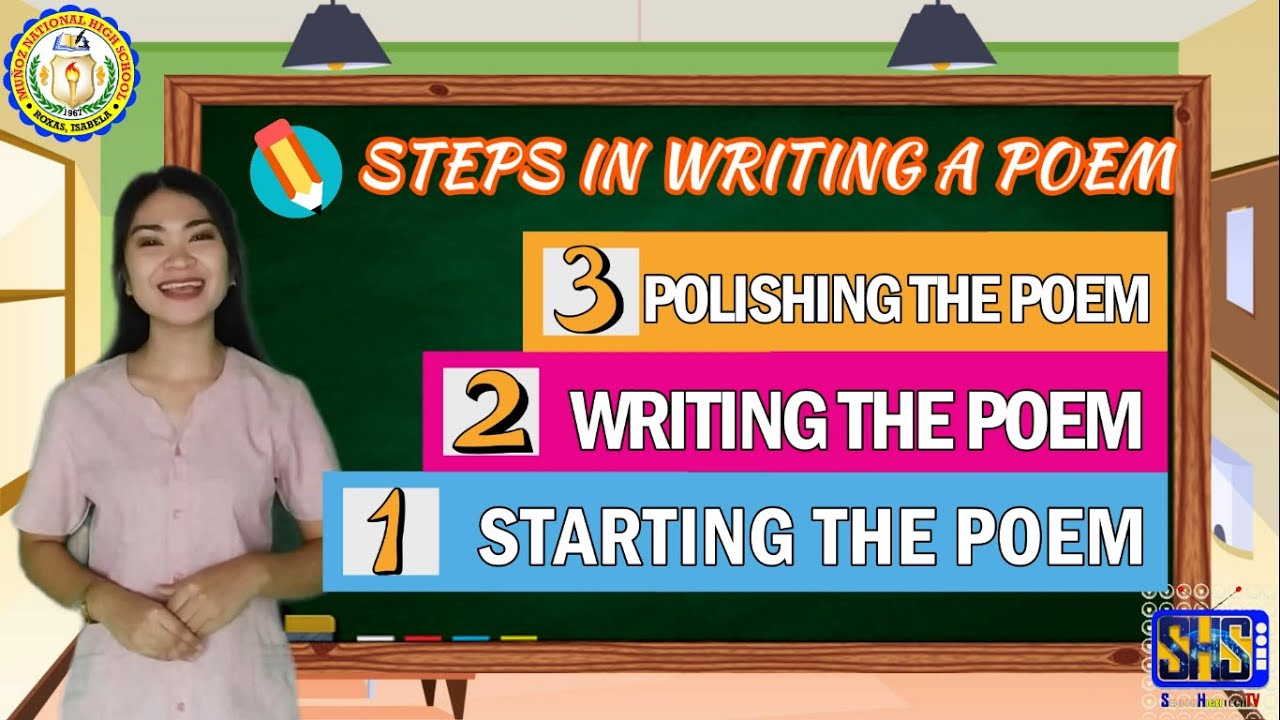Langkah Langkah Menulis Puisi
Summary
TLDRIn this educational video, Kak Aida guides young learners through the process of writing poetry. The video outlines six essential steps: selecting a central idea, noting interesting details related to the idea, crafting poetic lines with meaningful, often figurative language, organizing those lines into stanzas, choosing a title, and editing the poem for improvements. Through these steps, learners are encouraged to express their personal experiences and emotions creatively, making poetry writing an accessible and enjoyable activity.
Takeaways
- 😀 Determine the main idea (gagasan pokok) for your poem, which can come from personal experiences or significant memories.
- 😀 Make notes about interesting aspects of the main idea, such as what you saw, felt, or hoped during the experience.
- 😀 Use these notes to form poetic sentences that convey your ideas beautifully and meaningfully.
- 😀 Aim for words with connotations (indirect meanings) to make your poem sound richer and more engaging.
- 😀 Employ literary devices like metaphors and figures of speech to enhance the depth and expressiveness of your poem.
- 😀 Organize your poetic sentences into stanzas (group of lines) to create structure and flow in your poem.
- 😀 Choose a meaningful and catchy title that reflects the essence of your poem.
- 😀 Edit your poem to refine and improve it, replacing any words that don't fit or need adjustment.
- 😀 Writing a poem requires creativity, and these steps can guide you through the process step by step.
- 😀 Poetry can be a personal expression of emotions, memories, and experiences, so make your poem unique and authentic.
- 😀 The goal is to create a poem that is beautiful in both language and meaning, sharing your thoughts in a creative and meaningful way.
Q & A
What is the first step in writing a poem according to the video?
-The first step is to determine the main idea or 'gagasan pokok,' which can be based on memorable experiences such as visiting a beautiful place or a sad event.
What should you do after determining the main idea for your poem?
-After determining the main idea, you should write down interesting things related to that idea, such as observations about beauty, feelings, and any hopes or thoughts related to the experience.
What type of language should you use when writing a poem?
-You should use beautiful and meaningful words, including connotative meanings, which refer to meanings beyond the literal interpretation of words. Using literary devices like metaphors can also enhance the poem.
How should you organize the sentences you wrote for your poem?
-You should arrange the sentences you’ve written into stanzas (or 'bait') to create a cohesive structure for the poem.
What is the fifth step in the poem-writing process?
-The fifth step is to determine a title for the poem.
What does the editing process of the poem involve?
-The editing process involves reviewing the poem and making revisions, such as replacing words that don’t fit well or improving the flow and clarity of the poem.
Why is it important to use connotative meanings in a poem?
-Connotative meanings add depth to the poem, giving words additional layers of meaning, which can evoke stronger emotions and imagery in the reader.
What is the role of literary devices like metaphors in poetry?
-Literary devices such as metaphors help create vivid imagery and deeper meanings in the poem, enriching the reader’s experience by allowing them to interpret the poem in various ways.
How can personal experiences influence the creation of a poem?
-Personal experiences provide unique and authentic ideas for poems. Experiences such as visiting special places or reflecting on emotional moments can be turned into meaningful content for writing.
What should be done after finishing the poem in the learning process?
-After finishing the poem, the final task is to edit and revise it to ensure that the words and ideas flow well, ensuring clarity and beauty before finalizing it.
Outlines

Этот раздел доступен только подписчикам платных тарифов. Пожалуйста, перейдите на платный тариф для доступа.
Перейти на платный тарифMindmap

Этот раздел доступен только подписчикам платных тарифов. Пожалуйста, перейдите на платный тариф для доступа.
Перейти на платный тарифKeywords

Этот раздел доступен только подписчикам платных тарифов. Пожалуйста, перейдите на платный тариф для доступа.
Перейти на платный тарифHighlights

Этот раздел доступен только подписчикам платных тарифов. Пожалуйста, перейдите на платный тариф для доступа.
Перейти на платный тарифTranscripts

Этот раздел доступен только подписчикам платных тарифов. Пожалуйста, перейдите на платный тариф для доступа.
Перейти на платный тарифПосмотреть больше похожих видео
5.0 / 5 (0 votes)






